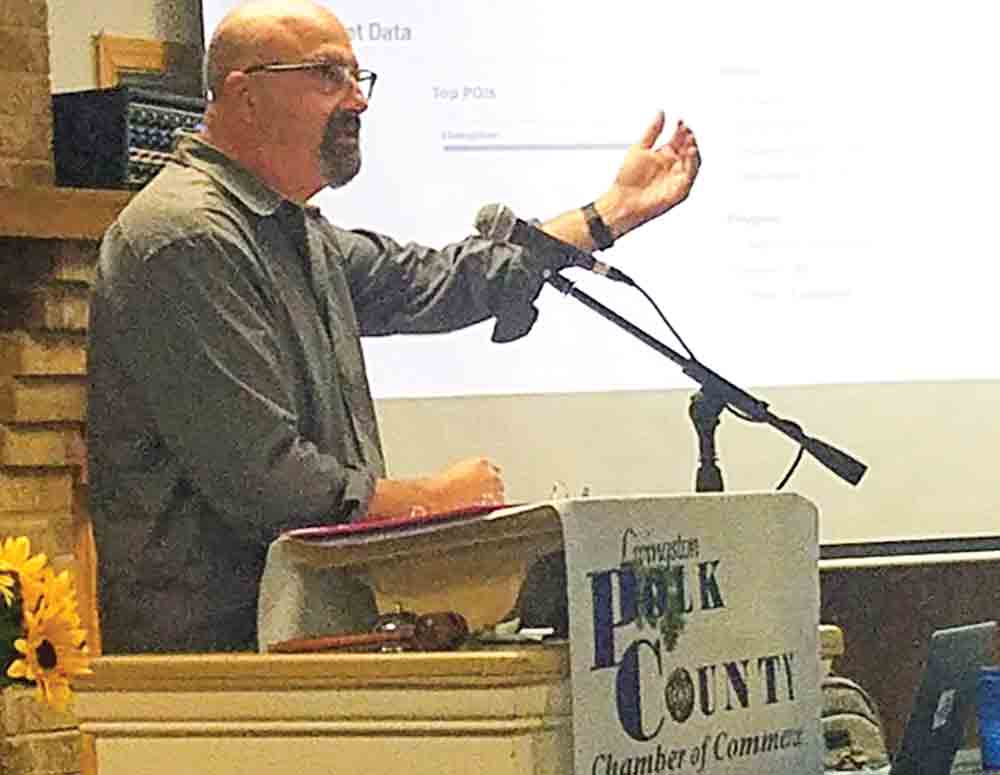Heritage tourism provides economic impact
 Del Polikretis spoke at the chamber luncheon recently. Photo by Emily Banks Wooten
Del Polikretis spoke at the chamber luncheon recently. Photo by Emily Banks Wooten
By Emily Banks Wooten
This email address is being protected from spambots. You need JavaScript enabled to view it.
Del Polikretis, executive director of the Texas Forest Trail Region Inc., a 501(c)3 nonprofit organization supported by the state, presented a program for those attending the Livingston-Polk County Chamber of Commerce quarterly membership luncheon April 25.
The Texas Forest Trail Region is part of the Texas Heritage Trails Program, the Texas Historical Commission’s (THC) award-winning heritage tourism initiative. This economic development initiative encourages communities, heritage regions and the state to partner and promote Texas’ historic and cultural resources. These local preservation efforts, combined with statewide marketing of heritage regions as tourism destinations, increase visitation to cultural and historic sites, thus bringing more dollars to Texas communities. This, in turn, supports the THC’s mission to protect and preserve the state’s historic and prehistoric resources for the use, education, economic benefit and enjoyment of present and future generations.
The Texas Heritage Trails Program is based around 10 scenic driving trails created in 1968 by Gov. John Connally and the Texas Highway Department as a marketing tool established in conjunction with HemisFair, an international exposition that commemorated the 250th anniversary of the founding of San Antonio.
In 1997, the state legislature charged the THC with creating a statewide heritage tourism program. The THC responded with a program based on local, regional and state partnerships, centered on the 10 scenic driving trails. These trails serve as the nucleus of 10 heritage regions and include heritage tourism attractions and communities both on and off the trail.
The 10 Texas Heritage Trail Regions are: Texas Forest Trail, Texas Brazos Trail, Texas Lakes Trail, Texas Mountain Trail, Texas Forts Trail, Texas Pecos Trail, Texas Hill Country Trail, Texas Plains Trail, Texas Independence Trail and Texas Tropical Trail.
“We work with the Texas Historical Commission and work on economic development and tourism. There are 10 regions and 10 executive directors operating independently. My trail has 35 counties, and my mission is to bring tax dollars and travelers to East Texas. We support Main Streets, museums and state historical sites,” Polikretis said.
The Texas Forest Trail Region includes Angelina, Anderson, Bowie, Camp, Cass, Cherokee, Gregg, Franklin, Hardin, Harrison, Henderson, Houston, Jasper, Jefferson, Marion, Montgomery, Morris, Nacogdoches, Newton, Orange, Panola, Polk, Red River, Rusk, Sabine, San Augustine, San Jacinto, Shelby, Smith, Titus, Trinity, Tyler, Upshur, Walker and Wood counties.
Related Articles
Each heritage region works to forge local tourism partnerships and support the region’s attractions by developing a unique blend of programs and promotions.
“Our partnership program is the financial backbone of our non-profit organization.
Every dollar you contribute supports the diverse programs we provide across the region in the form of education, advertising and outreach to the traveling public,” Polikretis said, adding that the annual flat fee to become a partner is $250.
“We actively engage on all platforms of social media, posting two times a day. We bring state and national attention to historic sites, preservation initiatives and regional attractions in East Texas. On average, our media posts reach 40,000 viewers and 1,500 active users weekly and we constantly analyze trends and methods for keeping our engagement high,” Polikretis said, adding that the social media handle is etxtraveler. He recommends visiting the following websites to learn more: texasforesttrail.org, etxtraveler.com and texastimetravel.com.
So what do the Texas Heritage Trail Regions do? They list heritage sites, attractions and events on TexasTimeTravel.com. They share stories at heritage education events developed for regional partners. They network with other heritage tourism professionals in the region. They participate as a co-op partner in travel and trade shows across the state. They participate in co-op advertising in Texas-targeted travel publications.
“We have a dedicated Livingston page, blog, list of events, photos and merch. There is a Destination Day video to drive people to your cities. We promote anything you want us to,” Polikretis said, adding that the staff can assist with marketing services such as artwork, brochure development and branding. “If you need help, we’ll help you. That’s what we do.”
Polikretis said he can also provide market data, giving the demographics of people coming in, based on cell phones within a 50-mile radius. He said the data shows the majority of people coming into Livingston are coming for day trips and that 91% are coming from within Texas.
Heritage tourism can have a direct economic impact on communities. In 2021, direct travel spending in the Forest Trail Region accounted for roughly $3.7 billion of the overall $76.6 billion spent by visitors to the state. A 2015 study by the University of Texas at Austin and Rutgers University determined that more than 10.5% of all travel in Texas is heritage related.
Following declines due to the pandemic, the Texas travel industry experienced a significant rebound in 2021. Travel spending increased an estimated 35.7% compared to the prior year and all economic indicators are approaching a pre-pandemic level.
You are a guest
or post as a guest
Be the first to comment.

